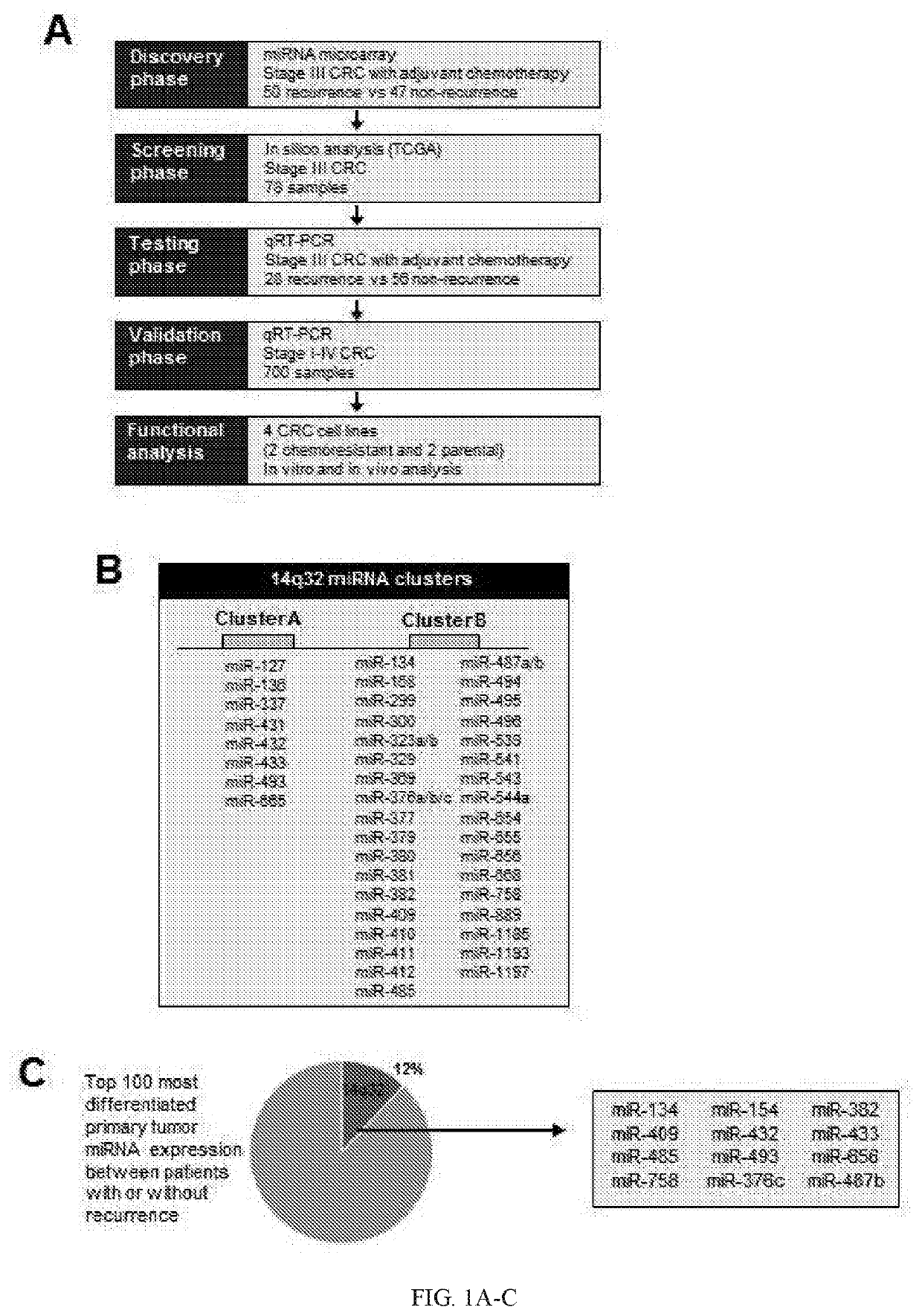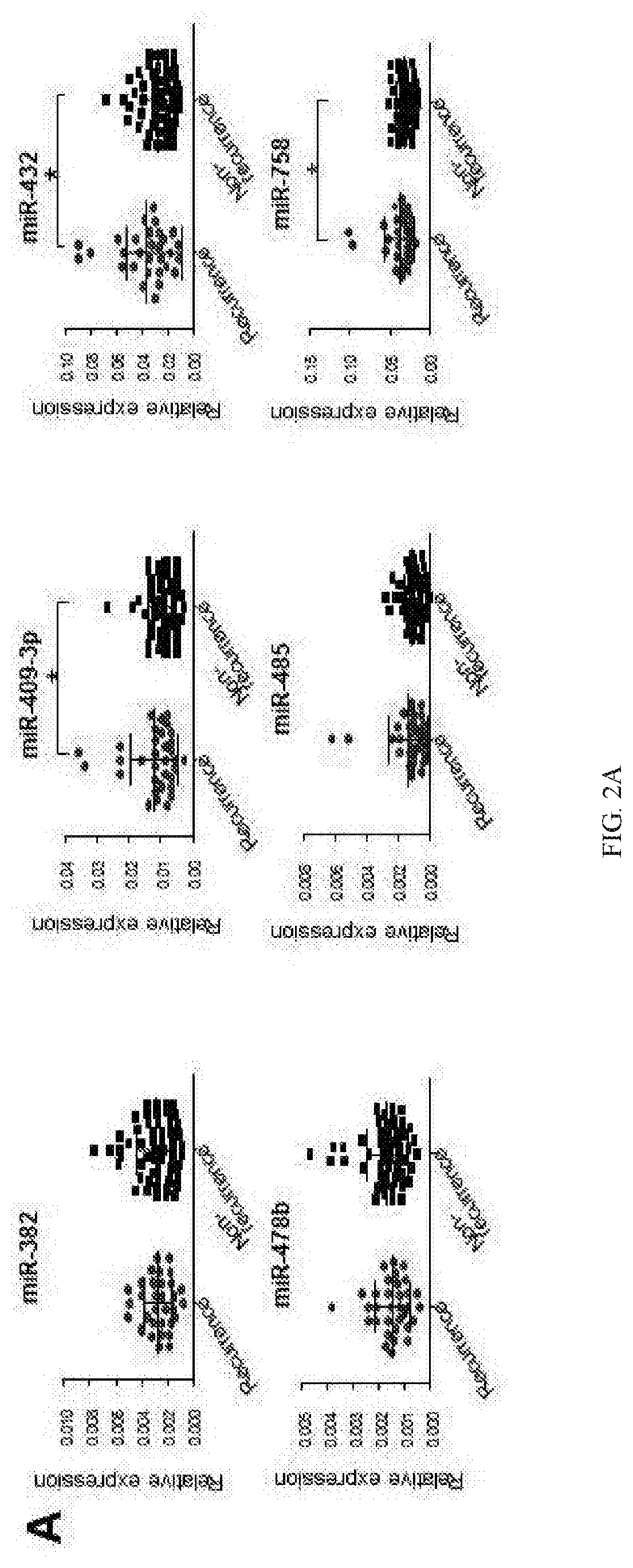Methods for diagnosing, prognosing, and treating colorectal cancer using biomarker expression
a colorectal cancer and biomarker technology, applied in the field of molecular biology and oncology, can solve the problems of high mortality associated with cr
- Summary
- Abstract
- Description
- Claims
- Application Information
AI Technical Summary
Benefits of technology
Problems solved by technology
Method used
Image
Examples
example 1
ation of a miRNA Cluster with Prognostic Biomarker Potential in Colorectal Cancer
[0188]Despite recent advances in colorectal cancer (CRC) treatments, approximately 30-50% of CRC patients who undergo curative resection subsequently experience tumor recurrence. Therefore, identification of reliable prognostic biomarkers that accurately select and stratify high-risk stage II & III CRC patients is paramount for individualized therapeutic strategies and ultimately improving patient outcomes. MicroRNAs (miRNAs) are small non-coding RNAs frequently dysregulated in various cancers and are emerging as promising cancer biomarkers. In this example, the inventors conducted a comprehensive miRNA expression profiling of tumors with or without tumor recurrence to identify a panel of miRNAs that are associated with tumor recurrence in CRC patients.
[0189]The inventors performed miRNA expression profiling in stage III primary CRC using multiple datasets to characterize miRNA signature and identify ta...
example 2
de Discovery and Identification of a Novel microRNA Signature for Recurrence Prediction in Colorectal Cancer
[0192]Colorectal cancer (CRC) is one of the leading causes of cancer-related deaths worldwide. In 2016, there were estimated 95,270 newly diagnosed CRC cases, and 49,190 deaths from this disease in the United States. Survival of patients is closely associated with the tumor stage at the time of diagnosis as 5-year relative survival rates range from 65% for all stages, 90% for localized primary tumor, 71% for regional metastasis and 13% for distant metastasis. Post-surgery, adjuvant therapy is only recommended to those with high risk stage II, as well as stage III and IV tumors. However, approximately 40-50% of the patients undergo curative surgery only and 20-30% that are treated with adjuvant chemotherapy, eventually relapse and experience a metastatic disease and eventual death. The current gold standard TNM (Tumor, Node, Metastasis) staging for determining the prognosis of ...
example 3
iRNA Signature for the Detection of Lymph Node Metastasis in Submucosal Colorectal Cancer Patients
[0196]Owing to recent advances in colonoscopic techniques, majority of submucosal colorectal cancers (T1 CRCs) can now be removed by endoscopic resection. Among these, 70% of T1 CRCs are deemed as “high risk” because they meet certain pathological risk factors including the presence of lymphovascular invasion, poor differentiation, and increased depth of tumor (>1000 um). However, post-surgical pathology data indicates that in reality only 10-15% of all T1 CRCs are genuinely high risk, while all other patients undergo unnecessary surgeries. Since current pathological criteria are inadequate, availability of more robust molecular biomarkers that may help identify ‘genuine high risk patients with lymph node (LN) metastasis’ more accurately will reduce the burden of surgical overtreatments. Due to the growing interest in developing miRNA biomarkers, the inventors undertook this study to id...
PUM
| Property | Measurement | Unit |
|---|---|---|
| length | aaaaa | aaaaa |
| size | aaaaa | aaaaa |
| thick | aaaaa | aaaaa |
Abstract
Description
Claims
Application Information
 Login to View More
Login to View More - R&D
- Intellectual Property
- Life Sciences
- Materials
- Tech Scout
- Unparalleled Data Quality
- Higher Quality Content
- 60% Fewer Hallucinations
Browse by: Latest US Patents, China's latest patents, Technical Efficacy Thesaurus, Application Domain, Technology Topic, Popular Technical Reports.
© 2025 PatSnap. All rights reserved.Legal|Privacy policy|Modern Slavery Act Transparency Statement|Sitemap|About US| Contact US: help@patsnap.com



